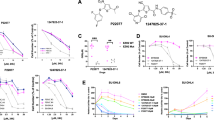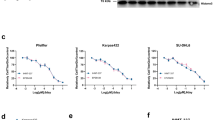Abstract
EZH2 catalyzes trimethylation of histone H3 lysine 27 (H3K27). Point mutations of EZH2 at Tyr641 and Ala677 occur in subpopulations of non-Hodgkin's lymphoma, where they drive H3K27 hypertrimethylation. Here we report the discovery of EPZ005687, a potent inhibitor of EZH2 (Ki of 24 nM). EPZ005687 has greater than 500-fold selectivity against 15 other protein methyltransferases and has 50-fold selectivity against the closely related enzyme EZH1. The compound reduces H3K27 methylation in various lymphoma cells; this translates into apoptotic cell killing in heterozygous Tyr641 or Ala677 mutant cells, with minimal effects on the proliferation of wild-type cells. These data suggest that genetic alteration of EZH2 (for example, mutations at Tyr641 or Ala677) results in a critical dependency on enzymatic activity for proliferation (that is, the equivalent of oncogene addiction), thus portending the clinical use of EZH2 inhibitors for cancers in which EZH2 is genetically altered.
This is a preview of subscription content, access via your institution
Access options
Subscribe to this journal
Receive 12 print issues and online access
$259.00 per year
only $21.58 per issue
Buy this article
- Purchase on Springer Link
- Instant access to full article PDF
Prices may be subject to local taxes which are calculated during checkout






Similar content being viewed by others
References
Kuzmichev, A., Nishioka, K., Erdjument-Bromage, H., Tempst, P. & Reinberg, D. Histone methyltransferase activity associated with a human multiprotein complex containing the Enhancer of Zeste protein. Genes Dev. 16, 2893–2905 (2002).
Cao, R. et al. Role of histone H3 lysine 27 methylation in Polycomb-group silencing. Science 298, 1039–1043 (2002).
Agger, K. et al. UTX and JMJD3 are histone H3K27 demethylases involved in HOX gene regulation and development. Nature 449, 731–734 (2007).
Hong, S. et al. Identification of JmjC domain-containing UTX and JMJD3 as histone H3 lysine 27 demethylases. Proc. Natl. Acad. Sci. USA 104, 18439–18444 (2007).
Lee, M.G. et al. Demethylation of H3K27 regulates polycomb recruitment and H2A ubiquitination. Science 318, 447–450 (2007).
Lan, F. et al. A histone H3 lysine 27 demethylase regulates animal posterior development. Nature 449, 689–694 (2007).
De Santa, F. et al. The histone H3 lysine-27 demethylase Jmjd3 links inflammation to inhibition of polycomb-mediated gene silencing. Cell 130, 1083–1094 (2007).
Kleer, C.G. et al. EZH2 is a marker of aggressive breast cancer and promotes neoplastic transformation of breast epithelial cells. Proc. Natl. Acad. Sci. USA 100, 11606–11611 (2003).
Varambally, S. et al. The polycomb group protein EZH2 is involved in progression of prostate cancer. Nature 419, 624–629 (2002).
Kirmizis, A. et al. Silencing of human polycomb target genes is associated with methylation of histone H3 Lys 27. Genes Dev. 18, 1592–1605 (2004).
Bracken, A.P. et al. EZH2 is downstream of the pRB-E2F pathway, essential for proliferation and amplified in cancer. EMBO J. 22, 5323–5335 (2003).
Simon, J.A. & Lange, C.A. Roles of the EZH2 histone methyltransferase in cancer epigenetics. Mutat. Res. 647, 21–29 (2008).
Velichutina, I. et al. EZH2-mediated epigenetic silencing in germinal center B cells contributes to proliferation and lymphomagenesis. Blood 116, 5247–5255 (2010).
van Haaften, G. et al. Somatic mutations of the histone H3K27 demethylase gene UTX in human cancer. Nat. Genet. 41, 521–523 (2009).
Wang, S., Robertson, G.P. & Zhu, J. A novel human homologue of Drosophila polycomblike gene is up-regulated in multiple cancers. Gene 343, 69–78 (2004).
Morin, R.D. et al. Somatic mutations altering EZH2 (Tyr641) in follicular and diffuse large B-cell lymphomas of germinal-center origin. Nat. Genet. 42, 181–185 (2010).
Lohr, J.G. et al. Discovery and prioritization of somatic mutations in diffuse large B-cell lymphoma (DLBCL) by whole-exome sequencing. Proc. Natl. Acad. Sci. USA 109, 3879–3884 (2012).
Morin, R.D. et al. Frequent mutation of histone-modifying genes in non-Hodgkin lymphoma. Nature 476, 298–303 (2011).
Sneeringer, C.J. et al. Coordinated activities of wild-type plus mutant EZH2 drive tumor-associated hypertrimethylation of lysine 27 on histone H3 (H3K27) in human B-cell lymphomas. Proc. Natl. Acad. Sci. USA 107, 20980–20985 (2010).
Yap, D.B. et al. Somatic mutations at EZH2 Y641 act dominantly through a mechanism of selectively altered PRC2 catalytic activity, to increase H3K27 trimethylation. Blood 117, 2451–2459 (2011).
McCabe, M.T. et al. Mutation of A677 in histone methyltransferase EZH2 in human B-cell lymphoma promotes hypertrimethylation of histone H3 on lysine 27 (H3K27). Proc. Natl. Acad. Sci. USA 109, 2989–2994 (2012).
Miranda, T.B. et al. DZNep is a global histone methylation inhibitor that reactivates developmental genes not silenced by DNA methylation. Mol. Cancer Ther. 8, 1579–1588 (2009).
Tan, J. et al. Pharmacologic disruption of Polycomb-repressive complex 2-mediated gene repression selectively induces apoptosis in cancer cells. Genes Dev. 21, 1050–1063 (2007).
Copeland, R.A. Evaluation of enzyme inhibitors in drug discovery. A guide for medicinal chemists and pharmacologists (John Wiley & Sons, 2005).
Duquenne, C. et al. Indazoles. International patent application PCT WO2011140325 (2011).
Burgess, J. et al. Azaindazoles. International patent application PCT WO2012005805 (2012).
Xu, C. et al. Binding of different histone marks differentially regulates the activity and specificity of polycomb repressive complex 2 (PRC2). Proc. Natl. Acad. Sci. USA 107, 19266–19271 (2010).
Han, Z. et al. Structural basis of EZH2 recognition by EED. Structure 15, 1306–1315 (2007).
Margueron, R. et al. Role of the polycomb protein EED in the propagation of repressive histone marks. Nature 461, 762–767 (2009).
Yonetani, T. & Theorell, H. Studies on liver alcohol hydrogenase complexes. 3. Multiple inhibition kinetics in the presence of two competitive inhibitors. Arch. Biochem. Biophys. 106, 243–251 (1964).
Richon, V.M. et al. Chemogenetic analysis of human protein methyltransferases. Chem. Biol. Drug Des. 78, 199–210 (2011).
Chapman, P.B. et al. Improved survival with vemurafenib in melanoma with BRAF V600E mutation. N. Engl. J. Med. 364, 2507–2516 (2011).
Wigle, T.J. et al. The Y641C mutation of EZH2 alters substrate specificity for histone H3 lysine 27 methylation states. FEBS Lett. 585, 3011–3014 (2011).
Daigle, S.R. et al. Selective killing of mixed lineage leukemia cells by a potent small-molecule DOT1L inhibitor. Cancer Cell 20, 53–65 (2011).
Ben-Porath, I. et al. An embryonic stem cell-like gene expression signature in poorly differentiated aggressive human tumors. Nat. Genet. 40, 499–507 (2008).
Dornan, D. et al. Therapeutic potential of an anti-CD79b antibody–drug conjugate, anti–CD79b-vc-MMAE, for the treatment of non-Hodgkin lymphoma. Blood 114, 2721–2729 (2009).
Renan, M.J. How many mutations are required for tumorigenesis? Implications from human cancer data. Mol. Carcinog. 7, 139–146 (1993).
Kaelin, W.G. Jr. Choosing anticancer drug targets in the postgenomic era. J. Clin. Invest. 104, 1503–1506 (1999).
Li, R. & Stafford, J.A. Kinase Inhibitor Drugs (John Wiley & Sons, Inc., 2009).
Tsai, J. et al. Discovery of a selective inhibitor of oncogenic B-Raf kinase with potent antimelanoma activity. Proc. Natl. Acad. Sci. USA 105, 3041–3046 (2008).
Kwak, E.L. et al. Anaplastic lymphoma kinase inhibition in non–small-cell lung cancer. N. Engl. J. Med. 363, 1693–1703 (2010).
Copeland, R.A. Protein methyltransferase inhibitors as personalized cancer therapeutics. Drug Discov. Today Ther. Strateg. published online, doi:10.1016/j.ddstr.2011.08.001 (16 September 2011).
Copeland, R.A., Solomon, M.E. & Richon, V.M. Protein methyltransferases as a target class for drug discovery. Nat. Rev. Drug Discov. 8, 724–732 (2009).
Vedadi, M. et al. A chemical probe selectively inhibits G9a and GLP methyltransferase activity in cells. Nat. Chem. Biol. 7, 566–574 (2011).
Ernst, T. et al. Inactivating mutations of the histone methyltransferase gene EZH2 in myeloid disorders. Nat. Genet. 42, 722–726 (2010).
Nikoloski, G. et al. Somatic mutations of the histone methyltransferase gene EZH2 in myelodysplastic syndromes. Nat. Genet. 42, 665–667 (2010).
Ntziachristos, P. et al. Genetic inactivation of the polycomb repressive complex 2 in T cell acute lymphoblastic leukemia. Nat. Med. 18, 298–301 (2012).
Acknowledgements
We thank D. Johnston and A. Basavapathruni for performing DOT1L and WHSC1 enzyme selectivity assays, K. Kuplast for help with the LCC calculations, A. Santospago for preparation of assay plates and R. Gould for helpful discussions.
Author information
Authors and Affiliations
Contributions
L.J. made the enzymes. K.W.K. and E.J.O. designed compounds including EPZ005687. T.J.W., C.R.M. and C.J.S. performed the enzyme inhibition assays, and T.J.W. performed substrate competitions, Yonetani-Theorell analysis and the in vitro EZH2 pull-down assay. S.K.K., N.M.W., C.J.A., C.R.K., J.S. and J.D.S. performed the intracellular inhibition of H3K27 methylation ELISA. S.K.K. and N.M.W. performed the western blotting of all methyl marks and proliferation assays. S.K.K., N.M.W. and J.J.S. performed gene expression and cell cycle experiments. S.K.K., T.J.W., K.W.K., A.R., J.J.S., M.P.S., R.M.P., R.C., M.P.M., V.M.R., R.A.C. and H.K. designed studies and interpreted results. S.K.K., T.J.W., K.W.K. and R.A.C. wrote the paper.
Corresponding author
Ethics declarations
Competing interests
All of the authors are employees and shareholders of Epizyme, Inc.
Supplementary information
Supplementary Text and Figures
Supplementary Methods and Supplementary Results (PDF 5373 kb)
Supplementary Data Set 1
Supplementary Dataset 1.xlsx (XLS 140 kb)
Supplementary Data Set 2
Supplementary Dataset 2.xlsx (XLS 94 kb)
Rights and permissions
About this article
Cite this article
Knutson, S., Wigle, T., Warholic, N. et al. A selective inhibitor of EZH2 blocks H3K27 methylation and kills mutant lymphoma cells. Nat Chem Biol 8, 890–896 (2012). https://doi.org/10.1038/nchembio.1084
Received:
Accepted:
Published:
Issue Date:
DOI: https://doi.org/10.1038/nchembio.1084
This article is cited by
-
EZH1/2 as targets for cancer therapy
Cancer Gene Therapy (2023)
-
Systematic literature review reveals suboptimal use of chemical probes in cell-based biomedical research
Nature Communications (2023)
-
Discovery of IHMT-337 as a potent irreversible EZH2 inhibitor targeting CDK4 transcription for malignancies
Signal Transduction and Targeted Therapy (2023)
-
UHRF1/UBE2L6/UBR4-mediated ubiquitination regulates EZH2 abundance and thereby melanocytic differentiation phenotypes in melanoma
Oncogene (2023)
-
The roles of EZH2 in cancer and its inhibitors
Medical Oncology (2023)



